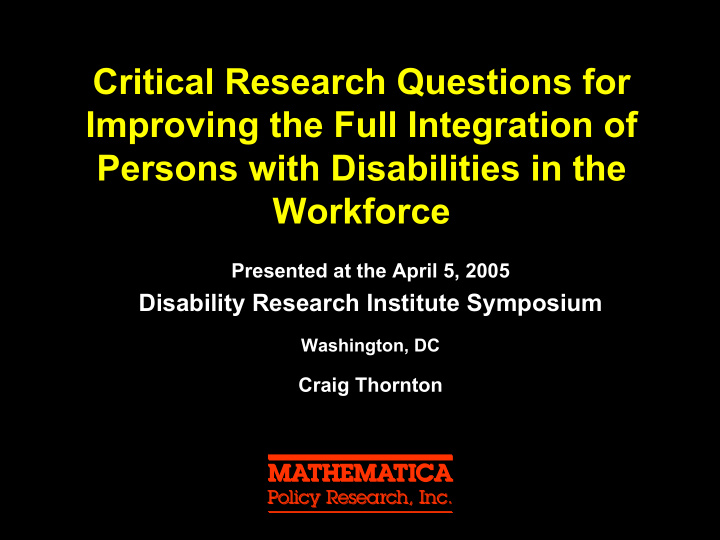



Critical Research Questions for Improving the Full Integration of Persons with Disabilities in the Workforce Presented at the April 5, 2005 Disability Research Institute Symposium Washington, DC Craig Thornton
Research Focus � All people with impairments or chronic illnesses who are limited in age-appropriate activities � Working–age adults � Youth and � Beneficiaries of disability insurance programs, particularly SSDI and SSI
Understanding Beneficiaries � Go beyond simple counts and demographics � Examine the 4 Es: � Employment � Experience � Education � Expectations
Why Would They Change Their Lives? � Leaving the rolls is a major life change � Where do beneficiaries turn for guidance and information? � What criteria are important in their decisions? � How can policies help them to understand or improve their options?
Why Did They Apply for Benefits? � What options did they see at the time of application? � Why do some people with similar impairments choose not to apply? � How can public policy effectively provide other options?
Understanding Employers � What do they look for in an employee? � How do they make hiring and retention decisions? � What interventions would increase employer willingness and ability to hire/retain workers with disabilities?
Methodology Matters � Identify valid comparison groups � Consistently measure outcomes for treatment and comparison groups � Study enough people to produce clear findings � Study people long enough to observe outcomes of interest
Effect on Employment Rates (STETS Demonstration) Treatment Control Site Group Group Difference New York 43 St. Paul 41
Effect on Employment Rates (STETS Demonstration) Treatment Control Site Group Group Difference New York 43 32 11 St. Paul 41 18 23
Ave. Monthly Earnings for TETD Dem onstration Participants and Nonparticipants 200.00 180.00 160.00 g in 140.00 n r a E 120.00 ly th n 100.00 o M e 80.00 g a r e v A 60.00 40.00 20.00 0.00 1 13 25 37 49 61 73 85 Months Pre- and Post- Random ization Control Treatment Elig . Nonparticipant
SSA Employment Program Paradoxes The programs promote employment for 1. people who have gone to great lengths to prove they cannot work. To promote equity, programs must be very 2. large, but may actually serve only a few beneficiaries.
Citations � Kerachsky Kerachsky, Stuart et al. , Stuart et al. “ “Impacts of Transitional Impacts of Transitional � Employment for Mentally Retarded Young Adults: Employment for Mentally Retarded Young Adults: Results of the STETS Demonstration.” ” New York: New York: Results of the STETS Demonstration. MDRC, April 1985. MDRC, April 1985. � Decker, Paul and Craig Thornton. Decker, Paul and Craig Thornton. “ “The Long Term The Long Term � Effects of Transitional Employment Services.” ” Social Social Effects of Transitional Employment Services. Security Bulletin , , vol vol 58, no 4 (Winter) 1995. 58, no 4 (Winter) 1995. Security Bulletin
Recommend
More recommend